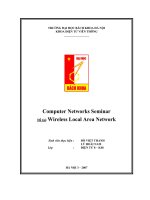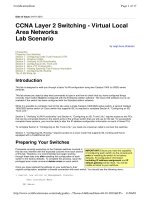en CCNAS v11 ch06 securing the local area network
Bạn đang xem bản rút gọn của tài liệu. Xem và tải ngay bản đầy đủ của tài liệu tại đây (1.67 MB, 131 trang )
Securing the Local Area Network
© 2012 Cisco and/or its affiliates. All rights reserved.
1
Which should be protected?
•
Securing the edge device because of its WAN connection?
•
Securing the internal LAN?
•
Both!
–
•
Securing the internal LAN is just as important as securing the perimeter of a network.
Internal LANs consists of:
–
Endpoints
–
Non-endpoint LAN devices
–
LAN infrastructure
© 2012 Cisco and/or its affiliates. All rights reserved.
2
Securing Endpoint Devices
•
A LAN connects many network endpoint devices that act as a network clients.
•
Endpoint devices include:
–
Laptops
–
Desktops
–
IP phones
–
Personal digital assistants (PDAs)
–
Servers
–
Printers
© 2012 Cisco and/or its affiliates. All rights reserved.
3
Securing Non-Endpoint Devices
•
A LAN also requires many intermediary devices to interconnect endpoint devices.
•
Non-endpoint LAN devices:
–
Switches
–
Wireless devices
–
IP telephony devices
–
Storage area networking (SAN) devices
© 2012 Cisco and/or its affiliates. All rights reserved.
4
Securing the LAN Infrastructure
•
A network must also be able to mitigate specific LAN attacks including:
–
MAC address spoofing attacks
–
STP manipulation attacks
–
MAC address table overflow attacks
–
LAN storm attacks
–
VLAN attacks
© 2012 Cisco and/or its affiliates. All rights reserved.
5
IronPort
•
IronPort is a leading provider of anti-spam, anti-virus, and anti-spyware appliances.
–
•
Cisco acquired IronPort Systems in 2007.
It uses SenderBase, the world's largest threat detection database, to help provide preventive and reactive security
measures.
© 2012 Cisco and/or its affiliates. All rights reserved.
6
Network Admission Control
© 2012 Cisco and/or its affiliates. All rights reserved.
7
NAC
•
•
NAC helps maintain network stability by providing four important features:
1.
Authentication and authorization
2.
Posture assessment
3.
Quarantining of noncompliant systems
4.
Remediation of noncompliant systems
NAC can be implemented in two ways:
–.
NAC Framework
–.
Cisco NAC Appliance
© 2012 Cisco and/or its affiliates. All rights reserved.
8
NAC Framework
•
The NAC framework uses the existing Cisco network infrastructure and third-party software to enforce security
policy compliance on all endpoints.
•
Suited for high-performance network with diverse endpoints.
–
Requires a consistent LAN, WAN, wireless, extranet, and remote access solution that integrates into the existing security and patch
software, tools, and processes.
© 2012 Cisco and/or its affiliates. All rights reserved.
9
NAC Framework
•
Different devices in the network, not necessarily one device, can provide the four features of NAC.
© 2012 Cisco and/or its affiliates. All rights reserved.
10
Cisco NAC Appliance
•
The Cisco NAC Appliance is a turnkey solution that condenses the four NAC functions into one appliance.
–
Natural fit for medium-scaled networks that need simplified and integrated tracking of operating system and anti-virus patches and
vulnerability updates.
•
–
It does not require a Cisco network.
–
It consolidates all the functions of the NAC framework into a single network appliance fulfilling all of the same roles.
Several major components accomplish these tasks:
© 2012 Cisco and/or its affiliates. All rights reserved.
11
Cisco NAC Components
•
•
•
•
Cisco NAC Appliance Server (NAS)
–
Device that provides in-band or out-of-band access control.
Cisco NAC Appliance Manager (NAM)
–
–
A web-based interface for creating security policies and managing online users.
The Cisco NAM manages the Cisco NAS, which is the enforcement component of the Cisco NAC Appliance.
Cisco NAC Appliance Agent (NAA)
–
–
Optional lightweight client for device-based registry scans in unmanaged environments.
It can determine whether a device has the required anti-virus dat file, security patch, or critical Windows hotfix.
Rule-set updates
–
Provides scheduled automatic updates for antivirus, critical hotfixes, and other applications.
© 2012 Cisco and/or its affiliates. All rights reserved.
12
Cisco NAA
Scan is performed
(types of checks depend on user role)
Login
Screen
Scan fails
Remediate
4.
© 2012 Cisco and/or its affiliates. All rights reserved.
13
Layer 2 Security
© 2012 Cisco and/or its affiliates. All rights reserved.
14
Types of Attacks
•
Layer 2 and Layer 3 switches are susceptible to many of the same Layer 3 attacks as routers.
–
Most of the security techniques for routers also apply to switches.
•
However, switches also have their own unique network attacks.
•
Most of these attacks are from users with internal access to the network.
© 2012 Cisco and/or its affiliates. All rights reserved.
15
Types of Attacks
•
MAC address spoofing
•
MAC address table overflows
•
STP manipulation
•
LAN storms
•
VLAN attacks
•
DHCP attacks
© 2012 Cisco and/or its affiliates. All rights reserved.
16
MAC Address Spoofing
© 2012 Cisco and/or its affiliates. All rights reserved.
17
MAC Address Spoofing
© 2012 Cisco and/or its affiliates. All rights reserved.
18
MAC Address Spoofing
© 2012 Cisco and/or its affiliates. All rights reserved.
19
MAC Address Spoofing
Mitigation
Mitigation techniques
techniques include
include configuring
configuring port
port security.
security.
© 2012 Cisco and/or its affiliates. All rights reserved.
20
MAC Address Table Overflow Attack
•
An
An attacker
attacker wishes
wishes to
to sniff
sniff packets
packets destined
destined to
to Servers
ServersA
Aand
and B.
B.
Attacker uses macof to generate multiple packets with
spoofed source MAC address.
To
Todo
do so,
so, he
he launches
launches aa MAC
MAC flood
flood attack.
attack.
•
Over a short period of time, the MAC address table fills
and no longer accepts new entries.
–
As long as the attack continues, the MAC address table
remains full.
•
Switch starts to broadcast (flood) packets all packets that
it receives out every port, making it behave like a hub.
VLAN 10
•
The attacker can now sniff packets destined for the
servers.
© 2012 Cisco and/or its affiliates. All rights reserved.
21
MAC Address Mitigation Techniques
•
Both MAC spoofing and MAC address table overflow attacks can be mitigated by configuring port security on the
switch.
•
•
Port security can either:
–
Statically specify the MAC addresses on a particular switch port.
–
Allow the switch to dynamically learn a fixed number of MAC addresses for a switch port.
Statically specifying the MAC addresses is not a manageable solution for a production environment.
–
Allowing the switch to dynamically learn a fixed number of MAC addresses is an administratively scalable solution.
© 2012 Cisco and/or its affiliates. All rights reserved.
22
STP Attack
•
An STP attack typically involves the creation of a bogus Root bridge.
•
This can be accomplished using available software from the Internet such as brconfig or stp-packet.
–
These programs can be used to simulate a bogus switch which can forward STP BPDUs.
Mitigation
Mitigation techniques
techniques include
include enabling
enabling PortFast,
PortFast, root
root guard
guard and
and BPDU
BPDU guard.
guard.
© 2012 Cisco and/or its affiliates. All rights reserved.
23
STP Attack
•
The attacking host broadcasts STP configuration and
topology change BPDUs to force spanning-tree
recalculations.
•
The BPDUs sent by the attacking host announce a
lower bridge priority in an attempt to be elected as the
root bridge.
•
If successful, the attacking host becomes the root
bridge and sees a variety of frames that otherwise are
not accessible.
© 2012 Cisco and/or its affiliates. All rights reserved.
24
LAN Storm Attacks
•
A LAN storm occurs when packets flood the LAN, creating excessive traffic and degrading network performance.
–
•
Possible causes:
•
Errors in the protocol stack implementation
•
Mis-configurations
•
Users issuing a DoS attack
Broadcast storms can also occur on networks.
–
Remember that switches always forward broadcasts out all ports.
–
Some necessary protocols, such as ARP and DHCP use broadcasts; therefore, switches must be able to forward broadcast traffic.
Mitigation
Mitigation techniques
techniques include
include configuring
configuring storm
storm control.
control.
© 2012 Cisco and/or its affiliates. All rights reserved.
25









